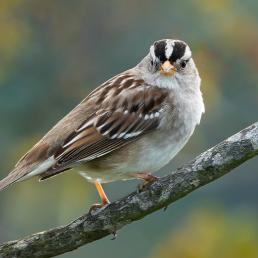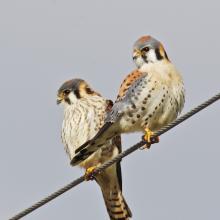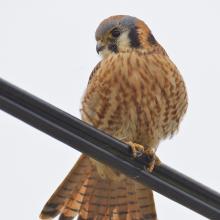

Join BirdNote tomorrow, November 30th!
Illustrator David Sibley and actor H. Jon Benjamin will face off in the bird illustration battle of the century during BirdNote's Year-end Celebration and Auction!
The American Kestrel is the smallest, most numerous, and most widespread North American falcon. This bird is built for speed, its long pointed wings often bent back at the tip. While hunting, kestrels hover above an open field. These days, the lack of suitable nesting cavities, which limits American Kestrel populations in some areas, has lead to public interest in installing wooden nest boxes.
Support for BirdNote is provided by Jim and Birte Falconer from Seattle, Washington, and generous listeners around the world.
BirdNote®
American Kestrel
By Frances Wood
This is BirdNote. [American Kestrels calling]
The American Kestrel – small, numerous, and widespread. [More kestrel calls] Watch for one of these North American falcons perched on a utility wire, bobbing its tail.
True to the name “falcon,” this species is built for speed, with long pointed wings, often bent back at the tip. If a suitable perch isn’t available, American Kestrels will hover above an open field. Facing into the wind, they flap their wings and use their tails to hold their position. From aloft, kestrels watch for insects, small mammals, and reptiles, which they overtake and capture. [Call of a kestrel] Don’t be fooled by their small size – equal to that of a robin – these are fierce hunters. Using their notched beaks, kestrels quickly subdue their prey by severing the spinal cord at the neck.
The lack of suitable nesting cavities limits kestrel populations in some areas. And this has lead people to install wooden nest boxes. Many states now have kestrel nest box programs, placing boxes along interstate highways. On I-35 in Iowa, there’s a kestrel box nearly every mile, from Minnesota to Missouri. [More kestrel calls.]
The kestrels readily adapt to these boxes and return each spring to set up housekeeping. You can find more about kestrels – including photos and plans for a nestbox – on our website, BirdNote.org. I’m Michael Stein.
Support for BirdNote is provided by Jim and Birte Falconer from Seattle, Washington, and generous listeners around the world.
###
Bird sounds provided by The Macaulay Library at the Cornell Lab of Ornithology, Ithaca, New York. Recorded by R.C. Stein. Ambient recording by G.A. Keller.
BirdNote's theme music was composed and played by Nancy Rumbel and John Kessler.
Producer: John Kessler
Executive Producer: Chris Peterson
© 2015 Tune In to Nature.org February 2018/2020 / May 2023
Narrator: Michael Stein
ID# AMKE-01b-2020-2-28 AMKE-01b
The American Kestrel is considered a “Bird of Conservation Concern” by the U.S. Fish and Wildlife Service.







